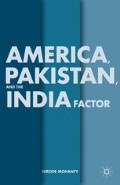Abstract
The War on Terror has moved into Pakistan’s territory. America’s blind reliance on Pakistan has caused the resurgent, resilient Taliban to foil the War on Terror and the Taliban want to settle for a Pakistan-backed negotiation to end the war. After 9/11, America (United States) declared the War on Terror and removed the Taliban administration from Kabul. The defeated Taliban and AQ terrorists took refuge in Pakistan. America provided multibillion dollar aid to Pakistan to use its land and air space to rout the Taliban and to capture AQ leader bin Laden. As in 1979, Pakistan became an American ally (and also an adversary). The relationship with Pakistan was strong after the Baghdad pact in 1955 but it deteriorated after the 1965 war with India. It became stronger again after Pakistan pioneered the mujahideen attacks on Afghanistan to oust the Soviets in 1979 and joined the War on Terror in 2001, but again, weakened after America’s war in Iraq in 2003. Things deteriorated significantly in May 2011 after the American military raid that killed AQ leader bin Laden in the garrison town of Abbottabad, Pakistan. Pakistani officials had denied his presence in their country. Relations ruptured further when US forces killed 24 Pakistani soldiers in November of the same year.
Access this chapter
Tax calculation will be finalised at checkout
Purchases are for personal use only
Preview
Unable to display preview. Download preview PDF.
Notes
Ahmed Rashid, Pakistan on the Brink (New York: Viking, 2012), 100.
Madeleine Albright, Memo to the President Elect (New York: Harper, 2008), 214;
Zbigniew Brezezinski, Second Choice (New York: Basic Books, 2008), 148;
Nick Paton Walsh, “Official: Pakistan Had But Didn’t Probe Data That Helped Make Raid,” CNN, May 2, 2011;
Dilip Hero, Apocalyptic Realm (New Haven, CT: YUP, 2012), 34–49.
Samuel Totten, William Parsons, and Israel Charny, eds., Century of Genocide: Eyewitness Accounts and Critical Views (New York: Routledge, 2004), 295–319.
Alex Von Tunzelmann, Indian Summer: The Secret History of the End of an Empire (New York: Henry Holt, 2007), 128, 180.
Nirode Mohanty, Radicalism in Islam: Resurgence and Ramifications (New York: Univ. Press of America, 2011).
Stephen Cohen, The Idea of Pakistan (Washington, DC: Brookings Institution Press, 2004), 34;
Ayesha Siddiqa writes in Military Inc. (Oxford, UK: OUP, 2007), 251:
H. V. Hodson, The Great Divide (New York: Atheneum, 1969), 469–470;
Dominique Lapierre and Larry Collins, Freedom at Midnight (New Delhi: Vikas Publishing House, 2005), 130–131, 196;
Stanley Wolpert, Jinnah of Pakistan (New York: OUP, 2005);
Narendra Singh Sarila, The Shadow of the Great Game: The Untold Story of India’s Partition (New York: Carroll and Graf Publishers, 2006), 9–10;
Stephen Tankel, Storming the World Stage (New York: CUP, 2011);
Samir Puri, Pakistan’s War on Terror (Oxon, UK: Routledge, 2012), 55.
Neta C. Crawford, “War Related Deaths and Injury in Pakistan, 2004–2011,” September 2011;
Bruce Riedel, Deadly Embrace (Washington, DC: Brooking Institute Press, 2011), 15.
Dr. Syed Rifaat Hussain, The India Factor in Pakistan: Beyond the Crisis State, Maleeha Lodhi, ed. (New York: CUP, 2011), 324.
Bob Woodward, Obama’s War (New York: Simon and Schuster, 2010), 208.
Arif Rafiq, “The Emergence of the Difa-e-Pakistan Islamist Coalition,” Combating Terrorism Center at West Point, March 22, 2012;
Rizwan, “With Friends Like Pakistan, the US Doesn’t Need Enemies,” All Voices, February 20, 2012.
David Sanger, Confront and Conceal (New York: Crown Publishers, 2012).
Pervez Hoodbhoy, Pakistan Is at Risk from Nuclear Weapons in Pakistan: Opposing Viewpoints, Laura Egendorf (ed.), (New York: Gale Cengage Learning, 2010), 175–182;
Seth Jones, “Why the Haqqani Network Is the Wrong Target,” Rand Objectives, November 6, 2011;
Arif Jamal, “The Growth of the Deobandi Jihad in Afghanistan,” Terrorism Monitor, vol. 8, no. 2 (January 14, 2010).
Dilip Hero, Apocalyptic Realm (New Haven, CT: YUP, 2012);
Akbar S. Ahmed, Jinnah, Pakistan and Islam Identity, (Oxford, Oxford University Press, 1997), 43.
Xenia Dormandy, “The Reversing Pakistan’s Descent,” Washington Quarterly (Spring 2012).35:2,pp157–173.
Alex Strick van Linschoten and Felix Kuehn, “Separating the Taliban from al-Qaeda,” Centre for International Cooperation, New York University, February 2011.
Robert Dreyfuss, “Talking with the Taliban,” January 31, 2012, http://www.thenation.com/blog/165954/talking-taliban;
Bill Clinton, My Life (New York: Alfred A, Knopf, 2004), 865.
Pamela Constable, Playing with Fire (New York: Random House, 2011), 159–182;
James Wynbrandt, A Brief History of Pakistan (New York: Facts on File, 2009), 202–225;
Touqir Hussain, The Islamization of Pakistan, 1979–2009, The Middle East Institute, Washington, DC, July 4, 2009;
Lawrence Wright, The Looming Tower Al Qaeda and the Road to 9/11 (New York: Alfred A. Knopf, 2006), 372;
Dennis Kux, The United States and Pakistan 1947–2000, (Washington, DC: Woodrow Wilson Center Press, 2001), 241.
The National Strategy Forum Review, “The U.S-Pakistan Relationship,” vol. 20, no. 2 (Spring 2011), www.nationalstrtegy.com;
Howard Schaffer and Teresita Schaffer, How Pakistan Negotiates with United States (Washington, DC: United States Institute of Peace, 2011).
Stephen Tankel, Storming the World Stage: The Story of Lashkar-e-Taiba (New York: CUP, 2011), 259.
Copyright information
© 2013 Nirode Mohanty
About this chapter
Cite this chapter
Mohanty, N. (2013). The Labyrinth: 2008–2012. In: America, Pakistan, and the India Factor. Palgrave Macmillan, New York. https://doi.org/10.1057/9781137323873_6
Download citation
DOI: https://doi.org/10.1057/9781137323873_6
Publisher Name: Palgrave Macmillan, New York
Print ISBN: 978-1-349-45886-8
Online ISBN: 978-1-137-32387-3
eBook Packages: Palgrave Political & Intern. Studies CollectionPolitical Science and International Studies (R0)

